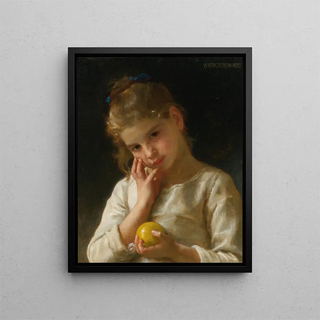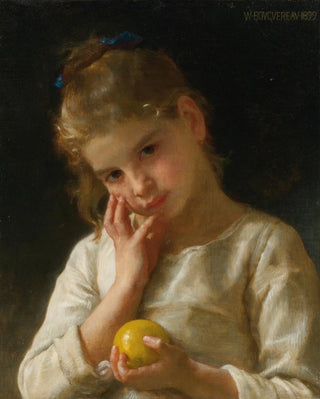Art print | The Lemon - William Bouguereau


View from behind

Frame (optional)
Art print Le citron - William Bouguereau – Engaging Introduction
In the rich and captivating universe of art, certain works stand out for their ability to capture the very essence of beauty. "Le citron" by William Bouguereau is one of those creations that fascinates and delights. This painting, both simple and complex, immerses us in a world where nature and art meet with unmatched delicacy. Through this piece, Bouguereau invites us to rediscover the beauty of ordinary things, transformed by his unique perspective. The soft light bathing the lemon, the delicate nuances of its skin, and the subtle background surrounding it create an atmosphere of serenity and harmony, encouraging us to contemplate life's simplicity.
Style and uniqueness of the work
Bouguereau's style is characterized by a realistic technique and meticulous attention to detail. In "Le citron," the artist manages to bring a simple fruit to life, transforming it into a subject of great beauty. Every brushstroke is an ode to light, color, and texture. The lemon, with its luminous reflections and delicate shadows, almost feels tangible, as if it could be touched. The composition of the piece is of rare elegance, where each element finds its place in perfect harmony. Bouguereau, a true master of light, succeeds in creating an intimate atmosphere, where the viewer is invited to approach and admire the beauty of everyday life. This work does not merely depict a fruit; it also evokes emotions and sensations, reminding us of the importance of contemplation.
The artist and his influence
William Bouguereau, an emblematic figure of the 19th century, is often regarded as one of the greatest painters of his time. His ability to merge realism with poetic sensitivity has influenced many artists and shaped the course of art history. Bouguereau was able, through his work, to redefine how nature and daily life could be represented. His commitment to classical beauty and his attention to detail made him a pioneer of realism, while maintaining a romantic dimension. Through works such as

Matte finish

View from behind

Frame (optional)
Art print Le citron - William Bouguereau – Engaging Introduction
In the rich and captivating universe of art, certain works stand out for their ability to capture the very essence of beauty. "Le citron" by William Bouguereau is one of those creations that fascinates and delights. This painting, both simple and complex, immerses us in a world where nature and art meet with unmatched delicacy. Through this piece, Bouguereau invites us to rediscover the beauty of ordinary things, transformed by his unique perspective. The soft light bathing the lemon, the delicate nuances of its skin, and the subtle background surrounding it create an atmosphere of serenity and harmony, encouraging us to contemplate life's simplicity.
Style and uniqueness of the work
Bouguereau's style is characterized by a realistic technique and meticulous attention to detail. In "Le citron," the artist manages to bring a simple fruit to life, transforming it into a subject of great beauty. Every brushstroke is an ode to light, color, and texture. The lemon, with its luminous reflections and delicate shadows, almost feels tangible, as if it could be touched. The composition of the piece is of rare elegance, where each element finds its place in perfect harmony. Bouguereau, a true master of light, succeeds in creating an intimate atmosphere, where the viewer is invited to approach and admire the beauty of everyday life. This work does not merely depict a fruit; it also evokes emotions and sensations, reminding us of the importance of contemplation.
The artist and his influence
William Bouguereau, an emblematic figure of the 19th century, is often regarded as one of the greatest painters of his time. His ability to merge realism with poetic sensitivity has influenced many artists and shaped the course of art history. Bouguereau was able, through his work, to redefine how nature and daily life could be represented. His commitment to classical beauty and his attention to detail made him a pioneer of realism, while maintaining a romantic dimension. Through works such as






